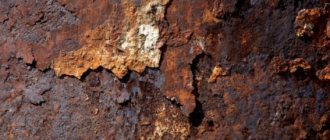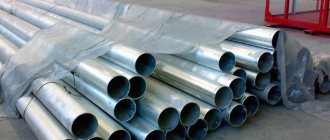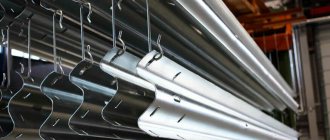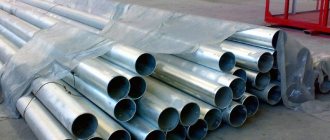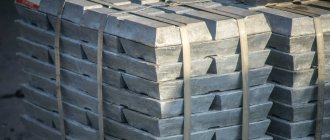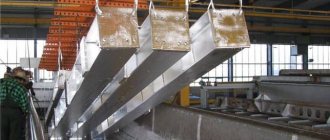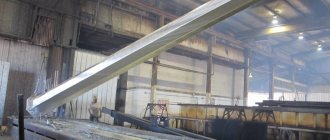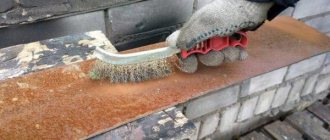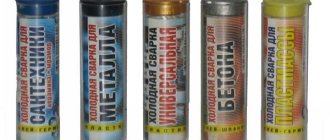Before carrying out work, it is recommended to check the humidity, air and substrate temperatures, as well as the dew point.
Option 1 – application by airless spray (optimal).
If necessary, dilute the primer with an appropriate solvent to working viscosity (but not more than 5% by weight of the material).
Optimal pressure is 100-160 bar, nozzle diameter is 0.013-0.017″.
Option 2 – application by pneumatic spraying:
If necessary, dilute the primer with an appropriate solvent to working viscosity (but not more than 10% by weight of the material).
The optimal pressure is 2.5-4 atm, the nozzle diameter is 1.4-2.5 mm.
Option 3 – application with a brush or roller.
If the soil is too thick, it can be diluted with an appropriate solvent for more convenient application (but not more than 5% by weight of the material).
Use only brushes and rollers that are resistant to organic solvents!
Properties, characteristics of cold galvanizing compositions
Cold galvanizing composition is an excellent alternative to hot zinc.
A distinctive feature of cold galvanizing compositions from any other types of zinc coatings is multi-level protection against corrosion. This is unattainable even for hot-dip galvanizing, because Many corrosion inhibitors simply decompose and lose their properties at the temperature of molten zinc.
Cold zinc provides triple protection against corrosion: it performs a barrier, protective and inhibitory function.
Barrier
This function of the cold galvanizing composition is to physically isolate the protected surface from aggressive environmental influences. In addition, upon contact with moisture, zinc oxidizes, forming water-insoluble zinc oxides and hydroxides. A dense film of oxides, covering the surface, prevents further penetration of moisture and oxygen into the thickness of the coating, providing additional barrier protection.
Tread protection
Zinc is characterized by a more electronegative electrochemical potential compared to iron. Once in an oxidizing environment, a galvanic cell is formed in which iron-based alloys, iron acts as a cathode, and zinc in the composition of cold galvanizing acts as an anode. There is a gradual dissolution of the anode, because he gives up his electrons. The cathode is not destroyed. This mechanism is called “cathodic protection”.
At the same time, the zinc layer itself may have minor mechanical defects (scratches, pores), which during operation are “clogged” with zinc corrosion products. Additional compaction of the coating occurs.
After applying the cold galvanizing composition to the surface, active, protective protection works for the first time, because Zinc oxides are still poorly formed, friable and allow the corrosive environment to pass through. Over time, after they are compacted, barrier protection begins to work - the oxides do not allow the corrosive environment to penetrate the protective layer. If the zinc coating is damaged (chip, scratch, etc.), active cathodic protection comes into play again.
Inhibitory
When corrosion inhibitors are included in the composition for cold galvanizing, in addition to electrochemical (cathodic) and barrier protection, another mechanism is involved in the system. Inhibitors slow down the rate of destruction by affecting the anodic, cathodic process, or both simultaneously.
Cold galvanizing of metal: technology, compositions, GOST
Products made from iron alloys are subject to corrosion when exposed to moisture and air. To protect against it, the surfaces of steel structures are coated with a zinc-based composition.
Until recently, three options for protective coating were used:
- hot galvanizing - dipping metal products into a zinc-based melt;
- spraying particles of molten zinc composition;
- thermal diffusion of zinc powder applied to the surface at high temperatures.
All these methods are labor-intensive, require special equipment and cannot be used for all metal structures, since they have restrictions on their size.
An alternative to these zinc coating methods is cold galvanizing technology.
What is cold galvanizing
Cold galvanizing means coating a steel surface with a zinc-containing composition using the usual method of applying paints, varnishes and other materials. The main component of such coatings is zinc powder, which has a highly dispersed structure.
Zinc, oxidizing upon contact with air and moisture, first takes on their destructive effect, distracting it from the destruction of iron in alloys, and then forms a durable film that mechanically prevents the penetration of moisture and serves as a corrosion protection for the metal.
Advantages of cold galvanizing of metals
Cold galvanizing technology provides many advantages:
- it is easy to implement;
- does not require complex equipment and special areas, as with the hot coating method;
- painting can be carried out on products of any size without dismantling them and directly at their location;
- the method makes it possible to carry out painting in the temperature range from -20°C to +40°C;
- provides high-quality protection during the service life;
- has high performance characteristics: wear resistance, high adhesion to the coated base, mechanical and thermal stability, self-healing ability.
Physico-chemical explanation of the cold galvanizing process
The basis for preventing corrosion of metal surfaces by cold coating with a zinc composition is the cathodic protection of alloys using electrons borrowed from zinc. Its essence is that, undergoing oxidation, zinc thereby protects iron or its alloy from corrosion.
The formation of rust FeO (OH) occurs in this way:
- As a result of corrosion, metal molecules decompose into negative electrons and positive cations. The scheme of this reaction is as follows: Me = Me z+ + z e-
- Free electrons, interacting with oxygen and water, form an alkaline group (OH-): O2+2 H2O+4e- = 4OH-
- Ions of this group will react with cations, forming a stable compound: x Me z+ + y OH- = Me x (OH)y
- In the case of iron, this is FeO (OH) - rust.
During the oxidation reaction of another metal, in this case zinc, which is part of the protective composition, it takes over the formation of electrons necessary for the reduction of oxygen molecules, and the iron stops oxidizing.
An important condition is to ensure electron permeability between zinc and iron; without this, the movement of electrons formed in zinc to iron is impossible.
The explanation for the anti-corrosion resistance of the zinc composition when applied to a steel (iron) surface lies in the low electrochemical potential of zinc compared to iron. This indicator for zinc is -760 mV, and for iron - -440 mV.
In the presence of moisture, zinc becomes an anode in relation to iron (cathode), donating electrons to it: Zn-2e*Zn2+, +> 2OH –
The reduction in the corrosion process of iron occurs due to the influence of the alkaline group (OH-), which neutralizes the oxidative process. The reason for using zinc as a protective layer for steel surfaces is that it corrodes much more slowly than iron in many environments.
Zinc cold coatings have two types of protection:
- protective, in the case of transfer of zinc electrons to the iron cathode;
- barrier, protecting like regular paint.
Protective protection is carried out at the initial stage after applying the composition, when it has not yet formed in the form of a stable film and is porous in nature, allowing moisture to reach the steel (iron) surface.
Advantages of cold galvanizing compositions
Liquid zinc can be used even in those conditions where it is impossible to galvanize using other methods (hot-dip galvanizing, galvanizing) due to the dimensions of the product or application conditions.
The compositions are widely used for repair work. They can serve as a base (primer) and be covered with any paint and varnish material, coating, or as an independent highly effective protective layer.
The undeniable advantages of cold galvanizing compositions:
- use when carrying out repair work, painting welds;
- possibility of welding after applying cold galvanizing composition;
- no restrictions on the overall dimensions of the structure being processed;
- high adhesion of the coating to the substrate (1 point) and finishing material;
- obtaining a high-quality elastic protective layer that does not crack, does not deform under shock, vibration and other loads, and withstands temperature fluctuations over a wide range (from -30 to +40°C and more);
- the possibility of self-painting, without professional equipment and the involvement of third-party specialists;
- painting with a cold galvanizing composition at the place of operation of the structure being protected, no disassembly or assembly or transportation required;
- long service life - at least 20 years!
Advantages of the method
Using the cold galvanizing method has a number of undeniable advantages:
- independence from the size of the product being processed;
- permissibility of galvanizing welds on site;
- ability to work in a wide range of ambient temperatures: from -20°C to +40°C ;
- high adhesion of the zinc-containing layer to paints and varnishes;
- obtaining an elastic coating resistant to mechanical and thermal deformation.
The undoubted advantages of protection include ease of use, relative cheapness and quick payback.
The cold galvanizing method has found wide application in the anti-corrosion protection of a wide variety of objects:
- building metal structures;
- bridges;
- hydraulic structures;
- reservoirs, cisterns;
- pipelines made of steel and ferrous metals;
- oil and gas pipelines;
- railway and water transport;
- agricultural machinery, etc.
Disadvantages of the method
All galvanizing methods have both advantages and disadvantages. The main disadvantage of cold galvanizing compositions is the high requirements for thorough preparation of the metal before applying the zinc-containing layer, compliance with all requirements for surface preparation and application and curing of the coating.
The cold galvanizing compositions themselves are distinguished by excellent protective characteristics and a long service life. But violation of the rules for surface preparation and painting specified in the technical specifications for the composition for cold galvanizing entails a deterioration in the quality of the coating and a reduction in its service life.
For example, if the quality of cleaning and degreasing is poor, dust, oil or grease stains may remain on the metal surface. In such areas, the adhesion of the protective layer will be low, and the coating will peel off over time.
Note:
All of the above information regarding technical characteristics and recommendations for applying LCM POLYMER materials is based on our theoretical knowledge and practical experience in using the products subject to the conditions of transportation and storage. The company is not responsible for damage caused by using the material for other purposes or in violation of the instructions for use, storage, transportation and subsequent operation of the coating. The material is intended only for professional and industrial use by specialists with the necessary theoretical knowledge and practical experience. You always have the right to request more up-to-date technical data by contacting our hotline.
Composition of cold galvanizing Akterm Zinc
Among professional compositions for cold galvanizing, Akterm Zinc has proven itself to be excellent.
The material can be applied to thin metal, it dries quickly, forms a high-quality protective layer that does not crack, and after drying it forms a smooth, matte, gray, velvety-to-the-touch coating that works on the principle of cathodic protection against corrosion.
The service life of the cold-galvanized layer is up to 40 years!
The composition of cold galvanizing includes chemically pure zinc powder with a fraction of 9 microns.
Thanks to its excellent rheological properties and consistency, liquid zinc paint is easy to mix and apply, filling surface defects and forming a continuous protective layer. Complete curing of the coating – 1.5 days.
The consumption of Akterm Zinc cold galvanizing composition is 1 kilogram of material per 4 square meters. m of metal to be painted.
The protective layer is characterized by the “Lotus Effect” - moisture particles do not linger on the polymer layer, collecting in drops and rolling off the surface.
The finished protective layer adheres firmly to the finishing coat. Compatible with powder paint, coatings on various bases: epoxy, acrylic, urethane-acrylic, chlorinated rubber, polyurethane, alkyd, vinyl chloride.
The cold galvanized layer does not smoke and does not burn when exposed to fire. Withstands temperatures up to +300 °C.
Safety precautions:
Use personal protective equipment (overall clothing, gloves, goggles, respirators). If the material comes into contact with exposed skin, immediately wash it off with clean water and soap, or remove it with a solvent. In case of contact with eyes, rinse them with plenty of water and consult a doctor immediately!
When carrying out work indoors, it is important to ensure good ventilation; do not use open flames or use welding equipment!
More detailed information regarding compliance with safety measures when working with the material can be obtained from specialists upon request.
Application
Cold galvanizing compositions, subject to the rules of storage, application, and operation, professionally protect metal products and structures from destruction. Widely used in many fields.
- Mechanical engineering, automotive industry
- Pipelines, fittings, metal products
- Civil, industrial construction
- Energy, oil and gas complex
- Bridge slabs, supports
- Transport: sea, river, land
- Power line supports, road barriers
- Containers, reservoirs, cisterns (including for water)
- Hydro- and port structures, railway facilities
- Artistic forging.
General information
As you know, galvanizing provides the most durable protection of metal against corrosion. The duration of this protection is 20-25 years. However, it is not always possible to perform galvanizing using traditional methods - “hot” or electrochemical deposition.
For example, this is difficult to achieve when finishing large metal structures. Moreover, it is impossible to apply the coating yourself at home. The way out of this situation was the use of zinc paint or, in other words, cold galvanizing.
This technology has properties that are practically not inferior to hot-dip galvanizing, but at the same time it is distinguished by a simple and affordable method of forming a protective coating. The composition is applied in the same way as other paints and varnishes.
Diagram of the difference between conventional coating and cold galvanizing
Features of zinc paint
Any zinc-rich paint contains zinc powder and a binder. Often such paints are conductive due to the high level of zinc content and a special binding component.
This material is able to provide double protection of metal from corrosion:
- Cathodic, since the coating is an anode in relation to the painted metal;
- Barrier, as is the case with conventional paints.
It must be said that the top barrier layer, among other things, also protects the zinc coating from mechanical damage. This allows you to increase its service life and reliability.
Cold galvanized metal pipe
Advantages of paint
In addition, zinc-containing paint has some other advantages:
- Unlike hot-dip galvanizing, it allows welds to be galvanized on site;
- Provides ease of welding of structures that are coated with cold galvanizing;
- Easy to apply;
- The damaged area can be tinted. For example, if the coating is damaged during transportation or installation.
- Has elasticity. Thanks to this, the coating withstands thermal expansion and mechanical deformation.
- It is highly compatible with almost all paints and varnishes. Therefore, it can be used as a primer for subsequent decorative painting.
- You can apply the composition yourself with any tool - brush, paint roller, dipping or spraying.
- Cold galvanizing corrodes much more slowly than hot galvanized zinc.
- Affordable price for the material.
Cold galvanizing of metal structures
Application area
Cold zinc paint is typically used for painting ferrous metals exposed to open atmospheres in temperate, cold, marine or tropical climates.
In particular, cold galvanizing is used for long-term corrosion protection:
- Bridges and hydraulic structures;
- Construction metal structures;
- Ship structures;
- Ports;
- Capacitive and pumping equipment;
- Overpass;
- Tanks;
- Reservoirs;
- Storage;
- Metal pipes;
- Gas pipelines;
- Power line supports;
- Agricultural machinery;
- Tunnels;
- Oil pipelines, etc.
Of course, paint with zinc can also be used for household purposes. For example, it can be used to paint heating radiators or water pipes.
As mentioned above, the composition can be used as a primer or as an independent coating. In the first case, 1-2 layers of the composition are applied, in the second - 2-3 layers.
Advice! Zinc paint can also be used for shop-to-shop protection of metal surfaces from corrosion. For example, before cutting, stamping, during storage, etc. In this case, it is enough to apply one thin layer of coating with a thickness of 40-50 microns.
Surface treatment by sandblasting
Cold galvanizing technology
The instructions for applying the composition are no different from working with regular paint and look like this:
- First of all, it is necessary to prepare the surface to be painted by cleaning it from old coating, scale, rust or other contaminants . It is best to sandblast the surface, but you can also use regular sandpaper. Ultimately, the coating must be applied to bare metal.
- After this, you need to stir the paint with a wooden stick until a homogeneous mass is obtained . If necessary, to obtain optimal viscosity, the composition can be diluted with a suitable solvent. The type of solvent is usually indicated in the description of the material.
- Then zinc paint is applied to the prepared base in a thin layer . As mentioned above, any painting tool can be used for these purposes. The main thing is that the coating should apply evenly, without streaks or smudges.
- After the first layer has dried, the procedure must be repeated again..
- To complete the work, the painted surface can be covered with several layers of decorative paint..
Advice! After painting, the instrument can be cleaned with organic solvents.
In the photo - cold galvanizing with a brush
As a result, a zinc coating with a zinc content of at least 95% is formed on the surface.
